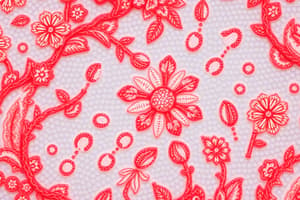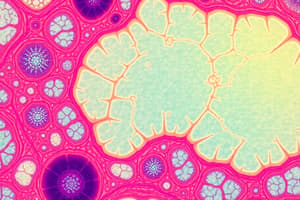Podcast
Questions and Answers
Which type of epithelial tissue is best suited for diffusion and filtration due to its thin, flat cells?
Which type of epithelial tissue is best suited for diffusion and filtration due to its thin, flat cells?
- Cuboidal epithelium
- Columnar epithelium
- Squamous epithelium (correct)
- Glandular epithelium
Which of the following is NOT a primary function of epithelial tissue?
Which of the following is NOT a primary function of epithelial tissue?
- Secretion
- Contraction (correct)
- Protection
- Absorption
Which type of connective tissue is characterized by a fluid matrix called plasma?
Which type of connective tissue is characterized by a fluid matrix called plasma?
- Blood (correct)
- Cartilage
- Bone
- Adipose tissue
Which type of cartilage provides the MOST flexible support to structures like the ear pinna?
Which type of cartilage provides the MOST flexible support to structures like the ear pinna?
What is the primary difference between tendons and ligaments in terms of the structures they connect?
What is the primary difference between tendons and ligaments in terms of the structures they connect?
Which of the following cell types is NOT found in areolar connective tissue?
Which of the following cell types is NOT found in areolar connective tissue?
Which feature distinguishes skeletal muscle from both smooth and cardiac muscle?
Which feature distinguishes skeletal muscle from both smooth and cardiac muscle?
Where is smooth muscle tissue typically found in the body?
Where is smooth muscle tissue typically found in the body?
What is the primary function of neuroglia cells in nervous tissue?
What is the primary function of neuroglia cells in nervous tissue?
Which part of a neuron is responsible for transmitting signals away from the cell body to other cells?
Which part of a neuron is responsible for transmitting signals away from the cell body to other cells?
Flashcards
Epithelial Tissue
Epithelial Tissue
Tissue that forms coverings or linings; functions in protection, absorption, secretion, and excretion.
Squamous Epithelium
Squamous Epithelium
Thin, flat epithelial cells; aid in diffusion and filtration.
Exocrine Gland
Exocrine Gland
Epithelium that secretes substances onto surfaces through ducts.
Connective Tissue
Connective Tissue
Signup and view all the flashcards
Blood
Blood
Signup and view all the flashcards
Cartilage
Cartilage
Signup and view all the flashcards
Ligament
Ligament
Signup and view all the flashcards
Tendon
Tendon
Signup and view all the flashcards
Muscular Tissue
Muscular Tissue
Signup and view all the flashcards
Skeletal Muscle
Skeletal Muscle
Signup and view all the flashcards
Study Notes
- Tissues are a group of cells with similar structure performing specific functions
- Animals possess four basic tissue types: epithelial, connective, muscular, and nervous
Epithelial Tissue
- It forms organ and cavity linings and coverings
- Functions include protection, absorption, secretion, and excretion
- Cells are tightly packed, leaving minimal intercellular space
- It rests on a non-cellular basement membrane
- It exists as simple (single layer) or stratified (multiple layers)
- Types include squamous, cuboidal, columnar, ciliated, and glandular
Squamous Epithelium
- It is composed of thin, flat cells
- Functions include diffusion and filtration
- Locations include blood vessel linings (endothelium) and lung air sacs (alveoli)
Cuboidal Epithelium
- Cube-shaped cells comprise it
- Functions include secretion and absorption
- Locations include kidney tubules and salivary glands
Columnar Epithelium
- Column-shaped cells comprise it
- Functions include secretion and absorption
- Locations include stomach and intestine linings
Ciliated Epithelium
- It consists of columnar or cuboidal cells featuring cilia
- It facilitates substance movement in one direction
- Locations include the respiratory tract and fallopian tubes
Glandular Epithelium
- This is specialized for secretion
- Forms unicellular (goblet cells) or multicellular glands
- Exocrine glands secrete onto epithelial surfaces via ducts
- Endocrine glands secrete hormones directly into the bloodstream
Stratified Epithelium
- It consists of multiple cell layers
- Primarily functions in protection from wear and tear
- Location example: skin as stratified squamous epithelium
Connective Tissue
- It connects, supports, and separates tissues and organs
- Cells are scattered within an extracellular matrix
- This matrix consists of ground substance and fibers
- Types include blood, bone, cartilage, ligaments, tendons, areolar, and adipose
Blood
- This is a fluid connective tissue
- Its matrix is plasma
- It contains red blood cells (RBCs, erythrocytes), white blood cells (WBCs, leukocytes), and platelets (thrombocytes)
- Functions include gas, nutrient, hormone, and waste transport, plus immune defense, and blood clotting
Bone
- A hard type of connective tissue
- Its matrix is composed of calcium phosphate and collagen fibers
- Bone cells (osteocytes) reside in lacunae
- Functions include support, protection, movement, mineral storage, and blood cell formation
Cartilage
- It is flexible connective tissue
- Its matrix is composed of chondrin
- Cartilage cells (chondrocytes) are located in lacunae
- Types include hyaline, elastic, and fibrocartilage
Hyaline Cartilage
- This is the most common cartilage type
- It is bluish-white and translucent
- Locations include long bone ends, the nose, and the trachea
Elastic Cartilage
- It contains elastic fibers
- It is flexible
- Locations include the ear pinna and epiglottis
Fibrocartilage
- It contains collagen fibers
- It is tough and strong
- Location: intervertebral discs.
Ligaments
- They connect bone to bone
- They are composed of dense regular connective tissue
- They exhibit high tensile strength
Tendons
- They connect muscle to bone
- They are composed of dense regular connective tissue
- They exhibit high tensile strength
Areolar Tissue
- This is loose connective tissue
- It contains fibroblasts, macrophages, and mast cells
- The matrix contains collagen and elastic fibers
- It functions in support and cushioning
- Locations include around organs and under the skin
Adipose Tissue
- It contains fat cells (adipocytes)
- Functions include energy storage, insulation, and cushioning
- Locations include under the skin and around organs
Muscular Tissue
- It is specialized for contraction and movement
- It contains muscle fibers (cells)
- Types include skeletal, smooth, and cardiac
Skeletal Muscle
- It exhibits a striated appearance
- It is under voluntary control
- It attaches to bones
- Its function is to move the skeleton
Smooth Muscle
- It is non-striated
- It is under involuntary control
- It is located in internal organ walls (e.g., stomach, intestine, blood vessels)
- It functions to move substances through internal organs
Cardiac Muscle
- It is striated
- It is under involuntary control
- It is located in the heart
- It functions to pump blood
Nervous Tissue
- It is specialized for communication and control
- It contains neurons (nerve cells) and neuroglia (supporting cells)
Neurons
- Function: transmits electrical signals (nerve impulses)
- Parts: cell body (soma), dendrites (receive signals), axon (transmits signals)
Neuroglia
- Neuroglia support, insulate, and protect neurons
- Examples include astrocytes, oligodendrocytes, microglia, and Schwann cells
Studying That Suits You
Use AI to generate personalized quizzes and flashcards to suit your learning preferences.




